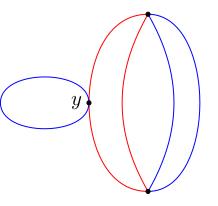
Below the video you will find accompanying notes and some pre-class questions.
(2.15) If we take \(\pi_1(S^1,1)=\mathbf{Z}\) and push it forward along \(p_n\) then we get the subgroup \[(p_n)_*\pi_1(S^1,1)=n\mathbf{Z}\subset\pi_1(S^1,1)=\mathbf{Z}.\] Note that, in this example, \[Deck(S^1,p_n)\cong\mathbf{Z}/(n\mathbf{Z})=\pi_1(X,x)/p_*\pi_1(Y,y)\] where \(p\colon Y\to X\) is the covering space.
(5.40) Is this a general phenomenon? No: the subgroup \(p_*\pi_1(Y,y)\subset\pi_1(X,x)\) might not be a normal subgroup, in which case the quotient \(\pi_1(X,x)/p_*\pi_1(Y,y)\) doesn't even make sense. However, in the case where \(p_*\pi_1(Y,y)\) is a normal subgroup of \(\pi_1(X,x)\), it will turn out to be true that \(Deck(Y,p)=\pi_1(X,x)/p_*\pi_1(Y,y)\). We single out these covers with a definition:
(9.56) Moreover, \(F\in Deck(Y,p)\) is determined uniquely by its value on a particular point \(y\in p^{-1}(x)\): indeed, any covering transformation is determined uniquely by its value at a point. Therefore, if the action of \(Deck(Y,p)\) is transitive on \(p^{-1}(x)\), then \(Deck(Y,p)\) is as big as it could possibly be: if it were any bigger, two of its elements would necessarily agree at some point \(y\in p^{-1}(x)\), and hence would be equal.
(12.29) In our earlier examples, the deck group acts transitively. For \(p_n\colon S^1\to S^1\), the \(n\)th roots of unity act transitively by rotation on \(p_n^{-1}(1)\), which it itself the set of \(n\)th roots of unity. For \(p\colon\mathbf{R}\to S^1\), the group \(\mathbf{Z}\) acts transitively by translation on \(p^{-1}(1)=\mathbf{Z}\).
(14.03) Below is a covering space of the figure 8 which is not normal.

(19.34) By assumption, \(Deck(Y,p)\) acts transitively, so there exists a deck transformation \(F\colon Y\to Y\) such that \(F(y)=\sigma_\beta(y)\) and deck transformations are homeomorphisms, so \[(F_*\colon\pi_1(Y,y)\to\pi_1(Y,\sigma_\beta(y))\] is an isomorphism. We also know that \(p\circ F=p\), so \(p_*\circ F_*=p_*\). Putting all this together gives: \begin{align*} \beta p_*\pi_1(Y,y)\beta^{-1}&= p_*\pi_1(Y,\sigma_\beta(y))\\ &=p_*(F_*(\pi_1(Y,y)))\\ &=p_*\pi_1(Y,y). \end{align*} Since this holds for all \(\beta\in\pi_1(X,x)\), this shows that \(p_*\pi_1(Y,y)\subset\pi_1(X,x)\) is normal.
(21.50) Conversely, suppose that \(p_*\pi_1(Y,y)\) is a normal subgroup. Let \(y'\) be another point in \(p^{-1}(x)\) and let \(\tilde{\beta}\) be a path in \(Y\) from \(y\) to \(y'\). Then \(y'=\sigma_\beta(y)\) and \[p_*\pi_1(Y,y')=\beta p_*\pi_1(Y,y)\beta^{-1}.\] Since \(p_*\pi_1(Y,y)\) is normal, we get \(p_*\pi_1(Y,y')=p_*\pi_1(Y,y)\), so the existence theorem for covering isomorphisms implies that there exists a covering transformation \(F\colon Y\to Y\) such that \(F(y)=y'\). Therefore \(Deck(Y,p)\) acts transitively on \(p^{-1}(x)\).